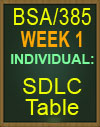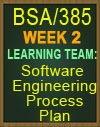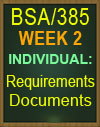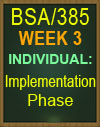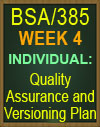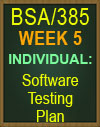|
BSA/385 Intro to Software Engineering |
|
|
Or you may purchase UOP Tutorials by the Week below... |
|
|
|
|
BSA/385 WEEK 1
All Week 1 Tutorials listed below are included in purchase!!
Individual: SDLC Table
Instructions:
The company you work for is a programming services contractor that
consults with businesses in the United States requiring assistance in
creating software in compliance with the Health Insurance Portability
and Accountability Act (HIPAA). Your company advertises a proven
track record in providing secure code that meets regulatory and
compliance recommendations that include the protection of all
Personally Identifiable Information (PII).
Your client is a small hospital and surgery center that requires a
program that will calculate the bill for a patient's hospital stay, including
charges for the surgery, daily hospital fees, and pharmacy. The hospital
only performs five types of surgeries, limits the patient stay to three
days, and has a limited pharmacy offering of ten prescription drugs. The
hospital employees who will use the program should be able to enter
the patient information, including name, hospital ID number, diagnosis,
surgery type, length of stay, and prescriptions. The program will then
produce a final billing statement. The client would like the program
completed in six months.
Using the file provided and referencing the scenario above, complete
the 2- to 3-page System Development Life Cycle Table. The table is
designed to help you see how to apply the SDLC to an actual program.
Cite all sources using APA guidelines.
Submit your assignment to the Assignment Files tab.
Discussion Question: Software Development Phases
(3 Answers Included)
As you read in Ch. 4, "Software Process Models," of Essentials of Software Engineering, there are several models
used in software development. The phases of requirements, design, implementation, test, and maintenance are
executed differently in the Waterfall versus a multiple-components incremental model.
Describe how the phases are executed differently in these two models, and discuss an advantage you see in using
one over the other if you were a software engineer designing a mobile application.
Discussion Question: “Functional” and “Non-Functional” Requirements (3 Answers Included)
In Ch. 1, "Creating a Program," of Essentials of Software Engineering, you examined how program requirements
statements that define and qualify the program are essential to the software development process. How would you
explain what the word "requirements" means to someone trying to make decisions about what they truly need from a
program?
Explain, in non-technical terms, what the differences are between "functional" and "non-functional" requirements.
|
|
|
|
|
BSA/385 Week 2
All Week 2 Tutorials listed below are included in purchase!!
Learning Team: Software Engineering Process Plan
Instructions:
The Learning Team Assignments will use the same scenario that is
used in the Individual Assignment in Week One.
This week the team will evaluate the User Stories that have been
gathered from the client. The Director of Software Engineering and the
Product Manager for your company visited the client and collected User
Stories as depicted in the User Stories document provided. The
Director wants you to look at the User Stories and identify the top five
critical requirements that the team will have to be concerned with for the
Functional Requirements Document (FRD) based on the stories.
In addition, you have been assigned an intern who will shadow you
during the development of this program. The intern has never heard of
a User Story and needs you to explain how you will use them.
Part 1:
Based on the stories, create a 1-page list using Microsoft® Word of the
top five critical requirements that the team will need to be concerned
with for the Functional Requirements Document. Include a justification
of why you think each requirement is critical.
Part 2:
Create a 1-page document using Microsoft® Word that explains the
following to the intern:
- How requirements for a software project are gathered
- What user stories are, why they are needed, and how they are used
The team will submit one completed assignment for the team. This
assignment will help you complete the Week Three Individual
Assignment.
Submit your assignment to the Assignment Files tab.
Individual: Requirements Document
Instructions:
Continue your work using the scenario presented in Week One.
The Director of Software Engineering and the Product Manager for the
company visited the client and collected the User Stories as depicted in
the User Stories document provided. In addition the Chief Financial
Officer of the Hospital gave the Director a complete breakdown of the
charges for surgeries, hospital stays, and prescription drugs.
Part 1:
The Director has asked you to read through the stories and help with
the Functional Requirements Document (FRD) which is a formal
statement of the program's functional requirements. The FRD serves
the same purpose as a contract. Your company agrees to provide the
capabilities specified. The client agrees to find the product satisfactory if
it provides the capabilities specified in the FRD. The Director has asked
you to identify any specific user interface, compliance, security, data,
and data access requirements identified in the stories. The Director also
wants to know which of the requirements you identify are functional or
non-functional. The Director has determined that you will use an Agile
approach to the development of the program.
Create a 1- to 2-page list using Microsoft® Word of the current
requirements the FRD will need. First, list all the requirements that are
functional, then list the non-functional requirements. The FRD will be
refined as the development proceeds, so this list is a starting point.
Part 2:
Your intern is struggling to understand the differences between Data
Flow Diagrams (DFDs) and Entity-Relationship Diagrams (ERDs).
To help your intern understand the difference, create a 1-page
comparison table using Microsoft Word showing the similarities and
differences between a Data Flow Diagram (DFD) and an Entity-
Relationship Diagram (ERD). The table should depict at least three
points of comparison, as well as a justification of why you would use
one approach over the other.
Cite all sources using APA guidelines.
Submit your assignment to the Assignment Files tab.
Discussion Question: Architectural and Detailed Design
(3 Answers Included)
Refer to Ch. 7, "Design: Architecture & Methodology," of Essentials of Software Engineering.
Summarize the differences between architectural and detailed design. Discuss the importance of requirements
specification in the detailed design to the programmer that will create code to the specification.
Discussion Question: Functional Requirements
(3 Answers Included)
In the Pluralsight course "Software Process Management," you learned about Waterfall, "V", Spiral, and Agile models.
Analyze the conditions that determine the program design and project management approach. How does a software
engineer's choice of model influences how the functional requirements document is written and used?
|
|
|
|
|
BSA/385 Week 3
Learning Team: Software Engineering Management Tools
Instructions:
Recall that the hospital only performs five types of surgeries, limits the
patient stay to three days, and has a limited pharmacy offering of ten
prescription drugs. And, the hospital employee using the program
should be able to enter the patient information, including name, hospital
ID number, diagnosis, surgery type, length of stay, and prescriptions.
Using Figure 6-8, "An example of a data flow diagram depicting a
customer order system," construct a 1-page data flow diagram for the
Hospital's billing program using Microsoft® Word.
The team will submit one completed assignment for the team. This
assignment will help you complete this week's Individual Assignment.
Cite all sources using APA guidelines.
Submit your assignment to the Assignment Files tab.
Individual: Implementation Phase
Instructions:
Continue your work using the scenario presented in Week One.
The Director of Software Engineering for the company has determined
that you will use an Agile approach for development of the program,
including the implementation phase of the program. The Director has
asked you to present to the rest of the team, including your intern, the
implementation phase for the program development.
Create a PowerPoint presentation containing 14 to 16 slides, including
an introduction and conclusion slide and detailed speaker notes, that
includes the following:
- A brief explanation of the Agile model and how an implementation
phase works within the model
- An example of a software management tool that can be used as you
implement the design
- A description of at least three user stories that will be critical to the
design process
- At least three technical design specifications for the program
- A brief description of what a Scrum Master does in the Implementation phase
- A simple illustration of a sprint used in the implementation phase
Note: Other applications like Adobe® Spark® or Microsoft® Sway® or
Mix® can be used instead of PowerPoint.
Cite all sources using APA guidelines.
Submit your assignment to the Assignment Files tab.
Discussion Question: Software Management Tools
(3 Answers Included)
Research the benefits of software management tools using the link provided as a starting point.
From a business perspective, analyze the advantages and disadvantages of software management tools. Pick one
tool that could be used in the Agile development of a billing program and explain your choice.
Discussion Question: Design Quality and Metrics
(3 Answers Included)
Research a current article that discusses the importance of design quality and the use of metrics in the software
development process.
Share your article with the class.
Specify at least one measurement of design quality and a metric that could be used in the software development
process using an Agile approach to a billing program and explain your choice.
|
|
|
|
|
BSA/385 Week 4
Learning Team: Software Quality Assurance
Instructions:
Continue your work using the scenario presented in Week One.
The Director of Software Engineering needs your help assuring the
team in using the appropriate quality assurance processes. The
Director wants you to send out an email to the team titled "Software
Quality Assurance: Processes and tools to ensure quality results."
Write a 1- to 2-page email using Microsoft Word that addresses the
following:
- Explain how the development process can benefit from software
quality assurance and why it is important to follow quality assurance
processes.
- Provide an example of what happens when quality assurance
policies are not followed.
Briefly explain the following attributes:
- Functional attributes
- Operational attributes
- Usability attributes
- Business attributes
- Structural attributes
Explain two quality assurance tools.
The team will submit one completed assignment for the team. This
assignment will help you complete this week's Individual Assignment.
Submit your assignment to the Assignment Files tab.
Individual: Quality Assurance and Versioning Plan
Instructions:
Continue your work using the scenario presented in Week One.
Iterative testing is an essential element of Agile. This requires tracking
the changes made and making sure all members of the team have the
correct version of the program.
Quality Assurance (QA) in Systems Development is a set of processes
that ensure the delivered systems meet the pre-defined expectations.
Note that QA is not testing. Software Configuration Management
consists of a set of tasks that track and control changes to the
environment. Configuration management incudes software source
version control.
The Director of Software Engineering has noted that some members of
the team are not following the company's Quality Assurance and
Version Plan and has asked you to present to the team in order to help
them and your intern understand the importance of the plan.
Part 1:
Create a PowerPoint presentation containing 10 to 12 slides, including
an introduction and conclusion slide and detailed speaker notes, that
includes the following:
- A brief description of Quality Assurance (QA) in Systems
Development and why it is important
- An illustration of the testing process in the Agile model
- A brief explanation of automated testing
- A logical description of the processes ensuring that the functionality,
security, and performance of the application are met
• An explanation of what versioning is and why versioning of the
program is necessary
Note: Other applications like Adobe® Spark® or Microsoft® Sway® or
Mix® can be used instead of PowerPoint®.
Part 2:
Using the Quality Attributes Table document provided, complete the 1-
page table of quality attributes.
Cite all sources using APA guidelines.
Submit your assignment to the Assignment Files tab.
Discussion Question: Quality Assurance
(3 Answers Included)
Consider the importance of quality and security assurance during the software development process.
Appraise the risks and disadvantages to the organization of implementing software applications that are not high
quality or are easily hacked. Providean example from the healthcare industry to support your view.
Discussion Question: Security Management
(3 Answers Included)
From the standpoint of Chief Security Officer, analyze why the security management processes should be included in
the development of software applications that are used in the healthcare industry.
|
|
|
|
|
BSA/385 Week 5
Learning Team: Software Engineering Testing
Instructions:
Continue your work using the scenario presented in Week One.
The Director of Software Engineering wants you to provide some
insights into test automation. The company is trying to include as much
software testing automation as possible.
Write a 1-page email to the Director using Microsoft® Word that would
help the company asses their choices. The email should include the
following:
- A list of three pros and three cons of test automation
- A comparison oftwo test automation tools, identifying a minimum of
two pros and two cons for each tool
- An explanation of how test automation tools are used in relation to
the SDLC stages
The team will submit one completed assignment for the team. This
assignment will help you complete the Individual Assignment.
Submit your assignment to the Assignment Files tab.
Individual: Software Testing Plan
Instructions:
Continue your work using the scenario presented in Week One.
The Director of Software Engineering would like to have you create a
new Software Testing Plan.
Using the Software Testing Plan document provided, develop a 3- to 4-
page software testing plan. The plan will include the following:
- Design and Develop: Software testing goals, assumptions, and
deliverables:
- Testing Goal
- Test Assumptions
- Quality Attributes
- Schedule in the Life Cycle
- Required Artifacts
- Test: Data: generation and automation tools:
- Test Data Generation Methods
- Test Automation
- Acceptance Test
- Deploy: Versioning, maintenance, and environment:
- Version Control
- Maintenance Plan
- Testing Environment
Cite all sources using APA guidelines.
Submit your assignment to the Assignment Files tab.
Discussion Question: Software Testing Techniques
(3 Answers Included)
Consider the need for robust software testing techniques.
Determine the characteristics for a software testing environment that best supports testing the software application you
are developing in your individual assignments.
Discuss the software testing environment you would create and how the environment would support the software
testing processes and help the software development project meet its quality assurance goals.
Discussion Question: Software Testing Plan
(3 Answers Included)
Find a current article that discusses how to create a software testing plan.
Share your article with the class.
Propose how a software engineer would develop a software testing plan for software development in the healthcare
industry.
|



